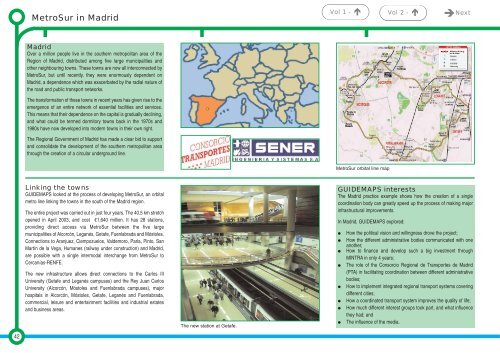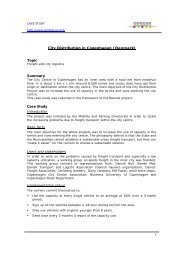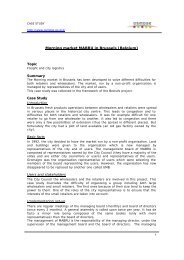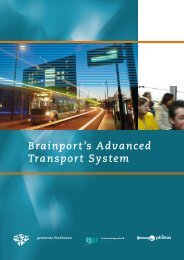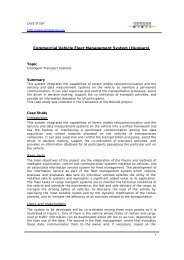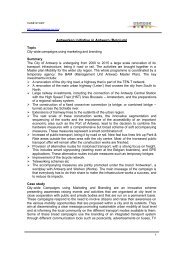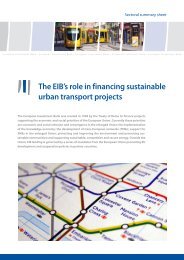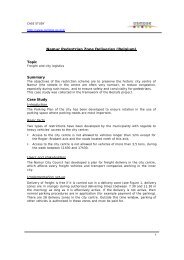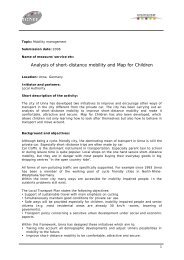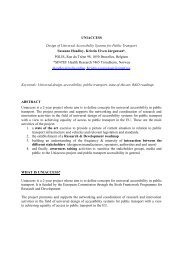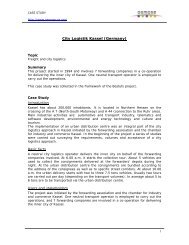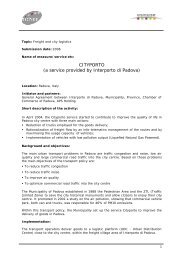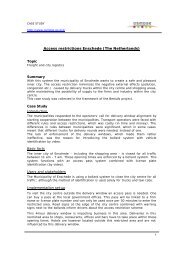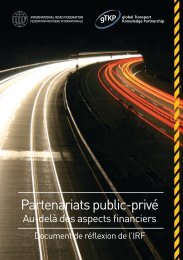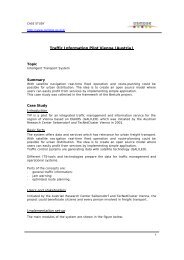Successful transport decision-making - Osmose
Successful transport decision-making - Osmose
Successful transport decision-making - Osmose
You also want an ePaper? Increase the reach of your titles
YUMPU automatically turns print PDFs into web optimized ePapers that Google loves.
MetroSur in Madrid<br />
Vol 1 - <br />
Vol 2 - <br />
Next<br />
Madrid<br />
Over a million people live in the southern metropolitan area of the<br />
Region of Madrid, distributed among five large municipalities and<br />
other neighbouring towns. These towns are now all interconnected by<br />
MetroSur, but until recently, they were enormously dependent on<br />
Madrid, a dependence which was exacerbated by the radial nature of<br />
the road and public <strong>transport</strong> networks.<br />
The transformation of these towns in recent years has given rise to the<br />
emergence of an entire network of essential facilities and services.<br />
This means that their dependence on the capital is gradually declining,<br />
and what could be termed dormitory towns back in the 1970s and<br />
1980s have now developed into modern towns in their own right.<br />
The Regional Government of Madrid has made a clear bid to support<br />
and consolidate the development of the southern metropolitan area<br />
through the creation of a circular underground line.<br />
MetroSur orbital line map<br />
Linking the towns<br />
GUIDEMAPS looked at the process of developing MetroSur, an orbital<br />
metro line linking the towns in the south of the Madrid region.<br />
The entire project was carried out in just four years. The 40.5 km stretch<br />
opened in April 2003, and cost €1,640 million. It has 28 stations,<br />
providing direct access via MetroSur between the five large<br />
municipalities of Alcorcón, Leganés, Getafe, Fuenlabrada and Móstoles.<br />
Connections to Aranjuez, Ciempozuelos, Valdemoro, Parla, Pinto, San<br />
Martín de la Vega, Humanes (railway under construction) and Madrid,<br />
are possible with a single intermodal interchange from MetroSur to<br />
Cercanías-RENFE.<br />
The new infrastructure allows direct connections to the Carlos III<br />
University (Getafe and Leganés campuses) and the Rey Juan Carlos<br />
University (Alcorcón, Móstoles and Fuenlabrada campuses), major<br />
hospitals in Alcorcón, Móstoles, Getafe, Leganés and Fuenlabrada,<br />
commercial, leisure and entertainment facilities and industrial estates<br />
and business areas.<br />
The new station at Getafe.<br />
GUIDEMAPS interests<br />
The Madrid practice example shows how the creation of a single<br />
coordination body can greatly speed up the process of <strong>making</strong> major<br />
infrastructural improvements.<br />
In Madrid, GUIDEMAPS explored:<br />
<br />
<br />
<br />
<br />
<br />
<br />
<br />
<br />
How the political vision and willingness drove the project;<br />
How the different administrative bodies communicated with one<br />
another;<br />
How to finance and develop such a big investment through<br />
MINTRA in only 4 years;<br />
The role of the Consorcio Regional de Transportes de Madrid<br />
(PTA) in facilitating coordination between different administrative<br />
bodies;<br />
How to implement integrated regional <strong>transport</strong> systems covering<br />
different cities;<br />
How a coordinated <strong>transport</strong> system improves the quality of life;<br />
How much different interest groups took part, and what influence<br />
they had; and<br />
The influence of the media.<br />
42


